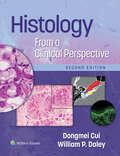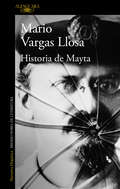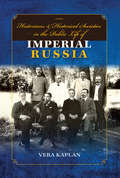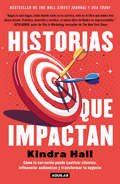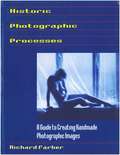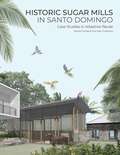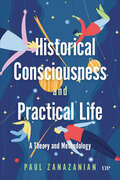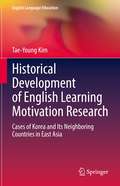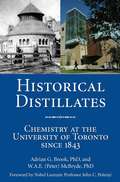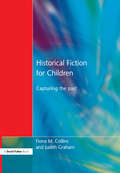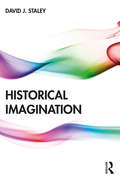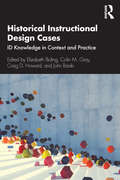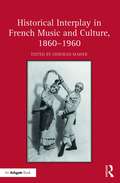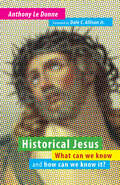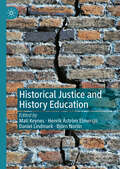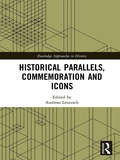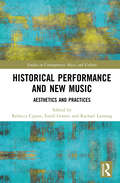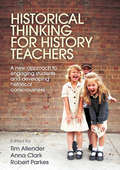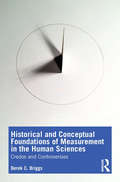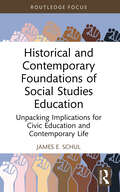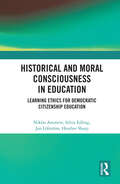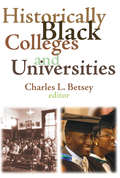- Table View
- List View
Histology From a Clinical Perspective
by Dongmei Cui William P. DaleyCombining a complete histology atlas with a concise, clinically oriented text, Histology from a Clinical Perspective, 2nd Edition, integrates essential basic science information and related pathology to ensure mastery of fundamental histology topics and the confidence to apply concepts effectively in practice. Explanatory text in each chapter is paired with expanded figure legends in an innovative layout that presents light and electron micrographic images of a tissue, a diagrammatic representation of the same tissue, and an example of how the tissue may be modified by a pathologic process in abundant Clinical Correlations. Rich with clinical vignette USMLE-style review questions and additional self-assessment resources, this student-friendly approach reflects the most up-to-date clinical perspectives and instills the understanding and skills to excel in today’s clinical settings.
Historia de Mayta (Biblioteca Breve Ser.)
by Mario Vargas Llosa«La historia de Mayta es incomprensible separada de su tiempo y lugar, aquellos años en que, en América Latina, se hizo religión la idea, entre impacientes, aventureros e idealistas (yo fui uno de ellos), de que la libertad y la justicia se alcanzarían a tiros de fusil.» Mario Vargas Llosa Mario Vargas Llosa nos arrastra con su prosa hacia Mayta, protagonista de una intentona revolucionaria trotskista que en la novela acontece en 1958. La reconstrucción de la historia de este personaje se lleva a cabo mediante los testimonios de aquellos que lo conocieron y la posterior confrontación de este relato, cargado de subjetivismo, con la realidad. El resultado solo podrá tener un claro regusto amargo y tragicómico. Así, aparte de conocer a un hombre, personificación de la marginalidad, hijo de un periodo de pasiones políticas y conflictos ideológicos, sabremos también de un momento clave en el devenir de América Latina, un tiempo sombrío, tiempo de reivindicación violenta de los deseos y los derechos, y, finalmente, comprenderemos las limitaciones de la verdad. Porque la historia procede de las ficciones personales. Y el lenguaje de la ficción traiciona inevitablemente la experiencia real. A menudo infravalorada, esta novela va mucho más allá de las lecturas políticas que en su momento la redujeron. Hoy, además, nos deleita con toda la altura literaria de Mario Vargas Llosa.
Historia de la Biblia
by Karen ArmstrongLa historia del libro más importante de todos los tiempos contada por Karen Armstrong, la mayor experta en religiones del mundo. La Biblia es el libro más famoso del mundo. Traducido a más de dos mil idiomas, se calcula que ha vendido más de seis mil millones de ejemplares solo en los últimos dos siglos. En esta excepcional crónica, Karen Armstrong sigue la creación de la Biblia para revelar un texto complejo y contradictorio, escrito por docenas de personas a lo largo de cientos de años. Armstrong comienza su análisis por los libros más antiguos de la Biblia hebrea, en los que Dios aparecía indistintamente como «Yahvé» y «Elohim», para seguir con el desarrollo del Antiguo y del Nuevo Testamento y sacar a relucir las distintas influencias que contribuyeron a dar forma a estos textos sagrados. Desde la práctica judía de la Midrás y el culto cristiano de Jesús hasta la influencia de las epístolas de san Pablo en la Reforma protestante y la manipulación del imaginario del Apocalipsis por el fundamentalismo cristiano, Armstrong explora el contexto en que estos sesenta y seis libros han sido interpretados y explica las necesidades sociales que buscaban satisfacer. El resultado revela una obra paradójica y desconocida, y cambiará para siempre nuestra visión de la Biblia. La crítica ha dicho... «Una excelente historia, amena y fascinante.»Julie Wheelwright, Independent
Historians and Historical Societies in the Public Life of Imperial Russia
by Vera KaplanWhat was the role of historians and historical societies in the public life of imperial Russia? Focusing on the Society of Zealots of Russian Historical Education (1895–1918), Vera Kaplan analyzes the network of voluntary associations that existed in imperial Russia, showing how they interacted with state, public, and private bodies. Unlike most Russian voluntary associations of the late imperial period, the Zealots were conservative in their view of the world. Yet, like other history associations, the group conceived their educational mission broadly, engaging academic and amateur historians, supporting free public libraries, and widely disseminating the historical narrative embraced by the Society through periodicals. The Zealots were champions of voluntary association and admitted members without regard to social status, occupation, or gender. Kaplan’s study affirms the existence of a more substantial civil society in late imperial Russia and one that could endorse a modernist program without an oppositional liberal agenda.
Historias que impactan: Cómo la narración puede cautivar clientes, influenciar audiencias y transformar
by Kindra HillEn el momento en que tomas el control de tus historias, tomas el control de tu negocio y de tu vida. "Hagas lo que hagas, estés donde estés en tu carrera, este es el libro que debes leer ahora mismo. Práctico, divertido y verídico, el nuevo libro de Kindra es imprescindible." -SETH GODIN, autor de This Is Marketing, bestseller de The New York Times Seguramente has escuchado que las historias son la mejor herramienta de negocios y que la narración de las mismas puede hacerlo todo, desde ayudar a los líderes a comunicarse mejor hasta motivar a los equipos de ventas y ganar clientes de la competencia. ¿Pero cuáles necesitas contar? ¿Y cómo hacerlo? En este libro, Kindra Hall, una reconocida narradora profesional y oradora, revela las cuatro historias únicas que puedes usar para diferenciar, cautivar y elevar: -La historia del valor: para convencer a los clientes de que necesitan lo que tú ofreces. -La historia de la fundación: para persuadir a los inversores y clientes de que vale la pena invertir en tu organización. -La historia del propósito: para alinear e inspirar a tus empleados y clientes internos. -La historia del consumidor: para permitir que aquellos que utilizan tu producto o servicio compartan tus experiencias auténticas con otros. Contarlas bien es una habilidad simple y accesible que cualquiera puede desarrollar. Con estudios de casos, perfiles de empresas y anécdotas respaldados por investigaciones, Kindra ofrece pasos específicos y accionables que puedes tomar para encontrar, crear y aprovechar las historias que ya tienes y que simplemente no estás contando.
Historic Avant-Garde Work on Paper (Routledge Research in Art History)
by Sascha Bru Laura KollwelterThis book examines the many functions of paper in the fine art and aesthetics of the early twentieth-century modernist or historic avant-garde (Expressionism, Cubism, Futurism, Dadaism, Surrealism, Constructivism and many more).With its many collages and photomontages, the historic avant-garde is generally considered to have transformed paper from a mere support into an artistic medium and to have assisted in art on paper gaining a firm autonomy. Bringing together an international team of scholars, this book shows that the story of paper in the avant-garde has thereby hardly been told. The first section looks at a selection of canonized individual avant-gardists’ work on paper to demonstrate that the material and formal analysis of paper in the avant-garde’s artistic production still holds much in store. In the second section, chapters zoom in on forms and formats of collective artistic production that deployed paper to move around reproductions of fine art works, to facilitate the dialogue between avant-gardists, to better promote their work among patrons, and to make their work available to a wider audience. Chapters in the third section lay bare how certain groups within the avant-garde began to massively create monochrome works, because these could be easily reproduced when transferred to, or reproduced as, linocuts. In the last section of the book, chapters explore how the avant-garde’s attentiveness to paper almost always also implied a critique of the ways in which paper, and all that it stood for, was treated and labored in European culture and society more broadly.The book will be of interest to scholars working in art history, modernism, and design.
Historic Photographic Processes: A Guide to Creating Handmade Photographic Images
by Richard FarberHistoric Photographic Processes is a comprehensive user's guide to the historical processes that have become popular alternatives to modern and digital technology. Though many of the techniques, applications, and equipment were first developed in the nineteenth century, these same methods can be used today to create hand-crafted images that are more attractive and permanent than conventional prints or digital outputs. Fine-art photographer Richard Farber incorporates extensive research with clearly-written directions and resource lists to provide in-depth information on eight of the most enduring processes in photographic history, including salted paper, albumen, cyanotype, kallitype, platinum/palladium, carbon/carbro, gum bichromate, and bromoil. He guides the reader through each step, from selecting the appropriate paper and sensitizing it to exposing, developing, and toning the final print. Each method is accompanied by a short explanation of how it was originally used and its significance in the evolution of photography. Historic Photographic Processes contains more than fifty color and ten black-and-white images that beautifully illustrate each of the processes described. Chapters include an introduction to photographic techniques and applications, such as useful safelights, sizing paper, measuring solutions, exposure controls, ultraviolet light sources, and making enlarged negatives, as well as an extensive section on safety in- and outside of the darkroom. The appendix provides important information on the chemicals discussed, as well as health-and-safety references, supply sources in the United States, Canada, and Europe, and a complete catalog of Internet resources.
Historic Sugar Mills in Santo Domingo: Case Studies in Adaptive Reuse
by Jaime Correa Carmen GuerreroDistributed by University Press of Florida on behalf of the Brian Canin Urban Design AwardColonial sugar mills, ingenios coloniales, are essential to the material history of the Dominican Republic. They served as a cornerstone of the national economy and as a foundation for the stability required during the colonial era. From the 1500s to the end of the 1800s, sugar mills and sugar factories were founded and sustained in what is now known as “La Ruta del Azucar,” or the Sugar Road. Colonial sugar mills not only represent a significant period in the country's history, but they also hold significant cultural and architectural value.In this volume, students at the School of Architecture of the University of Miami explore what is left of some of the most important ingenios coloniales in the Dominican Republic and, through an innovative approach of adaptive reuse, propose alternatives to celebrate their architectural value and cultural influences while also exploring the socio-economic and racial disparities and the political ideologies that are part of the history of these sites. The students approached the project with a spirit of innovation and the desire to document histories and possibilities for future generations in the Dominican Republic and to leave behind a legacy for new students to do similar work in urban and rural environments.
Historical Consciousness and Practical Life: A Theory and Methodology
by Paul ZanazanianHistorical Consciousness and Practical Life introduces a novel approach to examining how people construct and employ historical knowledge in their daily lives. In viewing history as an embodied cultural practice that constitutes the background to our meaning-making, the book demonstrates how researchers and others can investigate the ways in which people make sense of time’s flow in their now-moment engagements with the world and use that information to position themselves regarding key social problems with historical roots. The book provides a glimpse at how humans enter historically embedded thinking problems, seeking to resolve them. Paul Zanazanian draws on a study of the community leaders of English-speaking Quebec to illustrate the practical life methodology’s workings. In looking at their different uses of history for strengthening their group’s vitality in the province, he identifies five key stances these leaders employ for positioning their sense of purpose and responsibility for securing English-speaking Quebec’s future. Ultimately, Historical Consciousness and Practical Life argues that community leaders who complicate and problematize their uses of history are the best positioned to make positive transformations for their group.
Historical Development of English Learning Motivation Research: Cases of Korea and Its Neighboring Countries in East Asia (English Language Education #21)
by Tae-Young KimThis book clarifies the fundamental difference between North America-based instrumental motivation and Korea (and East Asia)-specific competitive motivation by which the EFL learners’ excessive competition to be admitted to famous universities and to be hired at a large-scale conglomerate is the main source of L2 motivation. It enables readers to understand that EFL-learning motivation reflects unique sociohistorical contexts grounded in a specific region or country. This book in turn necessitates the need to develop EFL motivation theory and research tradition which are firmly based on East Asian values and culture.
Historical Distillates: Chemistry at the University of Toronto Since 1843
by Adrian G. Brook W. A. E. Peter McBrydeHistorical Distillates examines the history of the Chemistry Department at the University of Toronto from its beginnings in 1843, when it was housed in simple quarters in the Parliament Buildings on Front Street and had just one faculty member. During the founding era (1843-1920) three British gentlemen professors guided the department through four homes; between 1920 and 1960 three Canadian heads built a highly influential department. Since 1960 eight chairmen have effectively managed a growing and diverse department while it ventured into exciting new fields and emerging sub-disciplines. New colleges and a Nobel Prize have been highlights of the past two decades. With the completion of recent renovations and additions (such as the Davenport Research Building and Garden), with its distinguished faculty, top-rate staff, and excellent students, and with its dazzling array of equipment to support research, the department’s future indeed looks bright.
Historical Fiction for Children: Capturing the Past
by Judith Graham Fiona M. CollinsHistorical fiction has a great deal to offer as its readers and devotees have always known. The time is ripe however for the historical novel and historical picture book to be promoted more emphatically so that many more are made aware of the delight and learning to be found in the genre. The editors of this book invited authors, academic writers and teachers to reflect on the nature, scope, range and richness of historical fiction for children. What is collected here provides an overview of the field, a consideration of significant writers of historical fiction from the nineteenth century onwards, a sense of the various historical eras commonly explored (Stone Age to World War 2), a discussion of commonly raised issues, themes and topics such as child labor, slavery and migration, and a forum for writers to reveal their insights into the writing of historical fiction. Julian Atterton, Berlie Doherty, Michael Foreman and Philip Pullman have made contributions. It provides evidence of children and students engaging creatively with historical fiction.
Historical Imagination
by David J. StaleyHistorical Imagination examines the threshold between what historians consider to be proper, imagination-free history and the malpractice of excessive imagination, asking where the boundary between the two sits and the limits of permitted imagination for the historian. We use "imagination" to refer to a mental skill that encompasses two different tasks: the reconstruction of previously experienced parts of the world and the creation of new objects and experiences with no direct connection to the actual world. In history, imagination means using the mind's eye to picture both the actual and inactual at the same time. All historical works employ at least some creative imagination, but an excess is considered "too much". Under what circumstances are historians permitted to cross this boundary into creative imagination and how far can they go? Supporting theory with relatable examples, Staley shows how historical works are a complex combination of mimetic and creative imagination and offers a heuristic for assessing this ratio in any work of history. Setting out complex theoretical concepts in an accessible and understandable manner and encouraging the reader to consider both the nature and limits of historical imagination, this is an ideal volume for students and scholars of the philosophy of history.
Historical Instructional Design Cases: ID Knowledge in Context and Practice
by Elizabeth Boling Colin M. Gray Craig D. Howard John BaakiHistorical Instructional Design Cases presents a collection of design cases which are historical precedents for the field with utility for practicing designers and implications for contemporary design and delivery. Featuring concrete and detailed views of instructional design materials, programs, and environments, this book’s unique curatorial approach situates these cases in the field’s broader timeline while facilitating readings from a variety of perspectives and stages of design work. Students, faculty, and researchers will be prepared to build their lexicon of observed designs, understand the real-world outcomes of theory application, and develop cases that are fully accessible to future generations and contexts.
Historical Interplay in French Music and Culture, 1860–1960
by Deborah MawerThis edited volume of case studies presents a selective history of French music and culture, but one with a dynamic difference. Eschewing a traditional chronological account, the book explores the nature of relationships between one main period, broadly the 'long' modernist era between 1860–1960, and its own historical ‘others’, referencing topics from the Romantic, classical, baroque, renaissance and medieval periods. It probes the emergent interplay, intertextualities and scope for reinterpretation across time and place. Notions of cultural meaning are paramount, especially those pertaining to French identity, national and individual. While founded on historical musicology, the approach benefits from interdisciplinary association with philosophy, political history, literature, fine art, film studies and criticism. Attention is paid to French composers’ celebrations and remakings of their predecessors. Editions of and writings about earlier music are examined, together with the cultural reception of performances of past repertoire. Organized into two parts, each of the eleven chapters characterizes a specific cultural network or temporal interplay, which may result in synthesis, disjunction, or historical misreading. The interwar years and those surrounding the Second World War prove particularly rich sources of enquiry. This volume aims to attract a wide readership of musicologists and musicians, as well as cultural historians, other humanities scholars and concert-goers.
Historical Jesus: What Can We Know and How Can We Know It?
by Anthony Le DonneHistorical Jesus asks two primary questions: What does “historical” mean? and How should we apply this to Jesus?Anthony Le Donne begins with the unusual step of considering human perception — how sensory data from sight, sound, touch, taste, and smell are interpreted from the very beginning by what we expect, what we’ve learned, and how we categorize the world. In this way Le Donne shows how historical memories are initially formed. He continues with the nature of human memory and how it interacts with group memories. Finally, he offers a philosophy of history and uses it to outline three dimensions from the life of Jesus: his dysfunctional family, his politics, and his final confrontation in Jerusalem.This little book is ideal for those with no background in religious studies — even those with no faith — who wish to better understand who Jesus was and how we can know what we do know about him.
Historical Justice and History Education
by Henrik Åström Elmersjö Daniel Lindmark Björn Norlin Mati KeynesThis book explores how the expectations of historical justice movements and processes are understood within educational contexts, particularly history education. In recent years, movements for historical justice have gained global momentum and prominence as the focus on righting wrongs from the past has become a feature of contemporary politics. This imperative has manifested in globally diverse contexts including societies emerging from recent, violent conflict, but also established democracies which are increasingly compelled to address the legacies of colonialism, slavery, genocides, and war crimes, as well as other forms of protracted discord. This book examines historical justice from an educational perspective, exploring the myriad ways that education is understood as a site of historical injustice, as well as a mechanism for redress. The editors and contributors analyse the role of history education in processes of historical justice broadly, exploring educational sites, policies, media, and materials. This edited collection is a unique and important touchstone volume for scholars, policy-makers, practitioners, and teachers that can guide future research, policy, and practice in the fields of historical justice, human rights and history education.
Historical Parallels, Commemoration and Icons (Routledge Approaches to History)
by Andreas LeutzschHistorical parallels, analogies, anachronisms and metaphors to the past play a crucial role in political speeches, historical narratives, iconography, movies and newspapers on a daily basis. They frame, articulate and represent a specific understanding of history and can be used not only to construct but also to rethink historical continuity. Almost-forgotten or sleeping history can be revived to legitimize an imagined future in a political discourse today. History can hardly be neutral or factual because it depends on the historian’s, as well the people’s, perspective as to what kind of events and sources they combine to make history meaningful. Analysing historical analogies – as embedded in narratives and images of the past – enables us to understand how history and collective memory are managed and used for political purposes and to provide social orientation in time and space. To rethink theories of history, iconology and collective memory, the authors of this volume discuss a variety of cases from Hong Kong, China and Europe.
Historical Performance and New Music: Aesthetics and Practices
by Rebecca Cypess, Estelí Gomez, and Rachael LansangThe worlds of new music and historically informed performance might seem quite distant from one another. Yet, upon closer consideration, clear points of convergence emerge. Not only do many contemporary performers move easily between these two worlds, but they often do so using a shared ethos of flexibility, improvisation, curiosity, and collaboration—collaboration with composers past and present, with other performers, and with audiences. Bringing together expert scholars and performers considering a wide range of issues and case studies, Historical Performance and New Music—the first book of its kind—addresses the synergies in aesthetics and practices in historical performance and new music. The essays treat matters including technologies and media such as laptops, printing presses, and graphic notation; new music written for period instruments from natural horns to the clavichord; personalities such as the pioneering singer Cathy Berberian; the musically “omnivorous” ensembles A Far Cry and Roomful of Teeth; and composers Luciano Berio, David Lang, Molly Herron, Caroline Shaw, and many others. Historical Performance and New Music presents pathbreaking ideas in an accessible style that speaks to performers, composers, scholars, and music lovers alike. Richly documented and diverse in its methods and subject matter, this book will open new conversations about contemporary musical life.
Historical Thinking and Other Unnatural Acts: Charting the Future of Teaching the Past
by Sam WineburgSince ancient times, the pundits have lamented young people's lack of historical knowledge and warned that ignorance of the past surely condemns humanity to repeating its mistakes. In the contemporary United States, this dire outlook drives a contentious debate about what key events, nations, and people are essential for history students. Sam Wineburg says that we are asking the wrong questions. This book demolishes the conventional notion that there is one true history and one best way to teach it. Although most of us think of history-and learn it-as a conglomeration of facts, dates, and key figures, for professional historians it is a way of knowing, a method for developing an understanding about the relationships of peoples and events in the past. A cognitive psychologist, Wineburg has been engaged in studying what is intrinsic to historical thinking, how it might be taught, and why most students still adhere to the "one damned thing after another" concept of history. Whether he is comparing how students and historians interpret documentary evidence or analyzing children's drawings, Wineburg's essays offer "rough maps of how ordinary people think about the past and use it to understand the present. " Arguing that we all absorb lessons about history in many settings-in kitchen table conversations, at the movies, or on the world-wide web, for instance-these essays acknowledge the role of collective memory in filtering what we learn in school and shaping our historical thinking. Author note: Sam Wineburg is Professor of Education at Stanford University and formerly Professor of Cognitive Studies in Education and Adjunct Professor of History at the University of Washington, Seattle.
Historical Thinking for History Teachers: A new approach to engaging students and developing historical consciousness
by Tim AllenderEffective Australian history education has never been more important for the development of critically aware and thoughtful young people. History fosters important skills in reasoning, historical consciousness and empathy; and an appreciation of history is crucial to the development of students' understanding of the very nature of our society. This edited collection comprises contributions from leading historians, educators and practising teachers, and surveys Australian history teaching today, from the development of the national curriculum to fostering historical thinking and promoting effective engagement in the history classroom.The book begins with an analysis of the principles underlying the drafting of the national curriculum and features insights from the writers of the curriculum themselves. It focuses on the curriculum from primary- and secondary-school teaching perspectives. Part 2 examines the teaching of historical expertise including historical thinking and value formation, as well as productive assessment and the important role social history can play in the classroom. Part 3 concentrates on specific approaches to history teaching including teacher talk; the use of historical fiction and film; digital technology and the internet; as well as museums as a teaching medium. Part 4 analyses key aspects of Australian history teaching including Indigenous perspectives, teaching citizenship and assisting the pre-service teacher in their transition to becoming a professional.Rich with insights into historical skills, historical concepts and critical thinking, as well as practical guidance on translating principles into engaging classroom approaches, this is an essential reference for both pre-service and in-service history teachers and educators.
Historical and Conceptual Foundations of Measurement in the Human Sciences: Credos and Controversies
by Derek C. BriggsHistorical and Conceptual Foundations of Measurement in the Human Sciences explores the assessment and measurement of nonphysical attributes that define human beings: abilities, personalities, attitudes, dispositions, and values. The proposition that human attributes are measurable remains controversial, as do the ideas and innovations of the six historical figures—Gustav Fechner, Francis Galton, Alfred Binet, Charles Spearman, Louis Thurstone, and S. S. Stevens—at the heart of this book. Across 10 rich, elaborative chapters, readers are introduced to the origins of educational and psychological scaling, mental testing, classical test theory, factor analysis, and diagnostic classification and to controversies spanning the quantity objection, the role of measurement in promoting eugenics, theories of intelligence, the measurement of attitudes, and beyond. Graduate students, researchers, and professionals in educational measurement and psychometrics will emerge with a deeper appreciation for both the challenges and the affordances of measurement in quantitative research.
Historical and Contemporary Foundations of Social Studies Education: Unpacking Implications for Civic Education and Contemporary Life (Routledge Research in Character and Virtue Education)
by James E. SchulThis book explores the rich history and depth of the educational field of social studies in the United States and examines its capacity to moderate modern-day anti-democratic forces through a commitment to civic education. Drawing out key significant historical moments within the development of social studies education, it provides a compelling historical narrative of the ideas that shaped the unique curricular field of social studies education. This book resynthesizes each historical stage to show how it resonates with contemporary life and effectively helps readers bridge the gap between theory and practice. Focusing on the key ideas of the field, and the primary individuals who championed those ideas, the author provides a clear, concise, and sharply pointed encounter with social studies education that illuminates the connection from research to practice. Researchers of social studies education will find this book to be a worthy contribution to the ever-important struggle to better understand the type of civic education necessary for the perpetuation of democratic life in the United States. It will also appeal to educational researchers and teacher educators with interests in the history of education, teacher education, civic education, moral education, and democracy.
Historical and Moral Consciousness in Education: Learning Ethics for Democratic Citizenship Education
by Silvia Edling Heather Sharp Niklas Ammert Jan LöfströmHistorical and Moral Consciousness highlights how ethics can be understood in the context of History education. It analyses the qualitative differences in how young people respond to historical and moral dilemmas of relevance to democratic values and human rights education. Drawing on a four-year international project, the book offers nuanced discussion and new scholarly understanding of the intersections between historical consciousness and moral consciousness within research. It develops new theoretical tools for history teaching and learning that can support teachers as they endeavor to educate for democratic citizenship. The book includes a meta-analysis of research within history Didaktik and around historical events with a moral bearing, and presents a comparative study of Australian, Finnish, and Swedish high school students’ moral understandings of historical dilemmas. Raising important questions about how our learning from the past is intertwined with our present and future interpretations and judgements, this book will be of great interest to academics, scholars, teachers, and post graduate students in the fields of history education, democratic education, human rights education, and citizenship education.
Historically Black Colleges and Universities
by Charles L. BetseyBeginning in the 1830s, public and private higher education institutions established to serve African-Americans operated in Pennsylvania and Ohio, the Border States, and the states of the old Confederacy. Until recently the vast majority of people of African descent who received post-secondary education in the United States did so in historically black institutions. Spurred on by financial and accreditation issues, litigation to assure compliance with court decisions, equal higher education opportunity for all citizens, and the role of race in admissions decisions, interest in the role, accomplishments, and future of Historically Black Colleges and Universities has been renewed. This volume touches upon these issues.Historically Black Colleges and Universities (HBCUs) are a diverse group of 105 institutions. They vary in size from several hundred students to over 10,000. Prior to Brown v. Board of Education, 90 percent of African-American postsecondary students were enrolled in HBCUs. Currently the 105 HBCUs account for 3 percent of the nation's educational institutions, but they graduate about one-quarter of African-Americans receiving college degrees. The competition that HBCUs currently face in attracting and educating African-American and other students presents both challenges and opportunities. Despite the fact that numerous studies have found that HBCUs are more effective at retaining and graduating African-American students than predominately white colleges, HBCUs have serious detractors. Perhaps because of the increasing pressures on state governments to assure that public HBCUs receive comparable funding and provide programs that will attract a broader student population, several public HBCUs no longer serve primarily African-American students.There is reason to believe, and it is the opinion of several contributors to this book, that in the changing higher education environment HBCUs will not survive, particularly those that are
